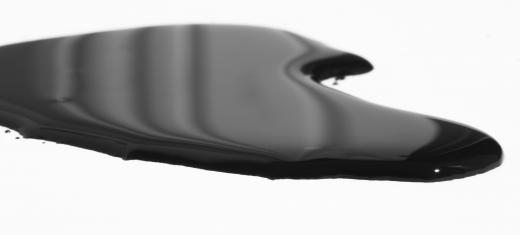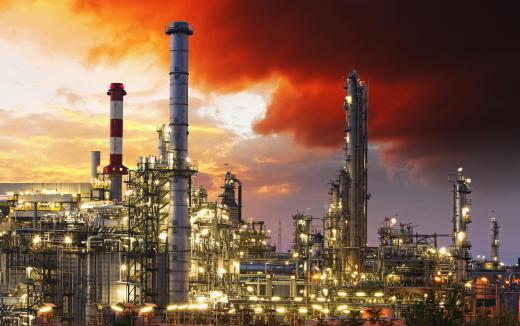What Is Hydrodesulfurization?
Hydrodesulfurization, also known as HDS, is a process in which sulfur is removed from crude oil, and oil-derived feedstock for the petrochemical industry, by combining it with hydrogen to form hydrogen sulfide (H2S). Crude oil is thought to have formed over millions of years from layers of dead plankton on the seabed. Since sulfur is present in all living things, there is a residue of sulfur in oil, in the form of sulfides and organic sulfur compounds such as thiols and thiophenes. These compounds are regarded as undesirable.
When oil or oil products containing sulfur compounds are burned, the sulfur is oxidized to sulfur dioxide (SO2), a pollutant that can cause respiratory problems and is a major contributor to acid rain. The burning of fossil fuels is the main source of SO2 pollution. Hydrodesulfurization became increasingly important following the passing, in many countries, of new regulations regarding sulfur levels in oil products in order to cut down SO2 emissions. As a result, oil refineries usually have an HDS unit.

Another problem with sulfur in oil is that it can reduce the effectiveness of the catalysts used to convert petroleum feedstock into other products. Sulfur in gasoline also affects catalytic converters in cars. It only requires very low levels to produce this effect, which is known as “poisoning” the catalyst.
In the hydrodesulfurization process, a mixture of the oil-based raw material and hydrogen gas is heated to 300-400°C and pumped under a pressure of up to 130 atmospheres into a hydrodesulfurization reactor. Here, the mixture passes over a catalyst which breaks the sulfur-carbon bonds, allowing the sulfur to react with the hydrogen to form hydrogen sulfide. There are a number of hydrodesulfurization catalysts, but the one most commonly used consists of molybdenum sulfide, which contains cobalt on an aluminum oxide base. The H2S flows out of the reactor, along with excess hydrogen, and into a treatment unit where it is separated out, allowing the hydrogen to be recycled through the process. Several cycles may be required to reduce the sulfur content to the required level.

The hydrogen sulfide produced by HDS is converted to elemental sulfur by a procedure known as the Claus Process — refineries generally have a Claus unit for this purpose. Much of the sulfur recovered in this way is used in the production of sulfuric acid. Although sulfur deposits are still mined, most sulfur production today is from petroleum via the HDS and Claus processes.
AS FEATURED ON:
AS FEATURED ON:













Discussion Comments
Is the process for taking carbon out of fossil fuels similar to the reaction used to take the sulfur or nitrogen out of fuels? Could one manipulate the reaction to run in reverse to remove carbon since the hydrogenolysis process, according to Alchemy, is used to split carbon bonds with oxygen, nitrogen and sulfur?
Why do some oil companies add nitrogen to fuels as engine cleaning additives? I would assume that adding nitrogen to fuels would be counterproductive to taking the nitrogen out of fuels. Is there a difference in the effects of the nitrogen in the additives and the nitrogen removed by the denitrogenation process?
I find this subject interesting, and I would like to learn more about how carbon is extracted from the hydrocarbon chain. I know that it is done, but I do not know how. I read that oil and gas mines in parts of Europe and the United States remove the carbon from oil underground. The carbon is removed in the form of carbon dioxide, which is then pumped into the rock to help release oil locked in harder to reach places. I would appreciate it if someone could explain to me how decarbonization is accomplished.
@Alchemy- That is interesting, I never realized that the fatty goodness of snack foods is created through the same process of taking sulfur and other pollutants out of petroleum. What I do not understand is why these fats are so bad for you.
Aren't they the same thing as oils and other liquid fats? Why are hydrogenated oils so much unhealthier than unsaturated oils? How do food manufacturers create margarine and butter spreads that do not have hydrogenated oils? Is the process used in these types of spreads just as harmful to the body as saturated fats created by hydrogenation?
@Georgesplane- Hydrogenation is also used for other purposes besides making petroleum products cleaner. Hydrogenation techniques similar to those used by the oil and gas industry are used to create hydrogenated oils. The process turns unsaturated fats into partially or completely saturated fats. This is the process of turning oils and liquid fats into solid and semi-solid fats. Think of the shortening and margarine that you use, and you are thinking about a product created by a hydrogenation reaction.
@Georgesplane- Hydrodesulfurization is actually a form of hydrogenation. The chemical reaction is actually a hydrogenolysis reaction. This type of reaction involves splitting the carbon bond with either sulfur, oxygen, or nitrogen. The end result is the addition of hydrogen into the reaction.
Hydrogenolysis reactions are used in other petroleum processing applications like hydrodenitrogenation. This process is used to remove nitrogen from hydrocarbons in almost the identical way that it removes sulfur from hydrocarbons.
The process makes fuels much cleaner and safer for the environment. The desulfurization and denitrogenation process reduce the impacts of sulfur and nitrogen dioxides, which can cause acid rain and environmental damage.
What is the reaction called that is used in hydrosesulfurization? How does the reaction work? Are there any other practical uses for this reaction?
@GenevaMech- I have a new found respect for the importance of fossil energy. I am a student at ASU studying renewable energy and sustainability, so I am a very pro renewable person. On the other hand, I am taking a policy development practicum with John Hoffmeister who is the former CEO of Shell Oil.
He is now an advocate for sustainable energy, and concedes that renewable energy must play a bigger role in the energy future of this country. He is also an advocate for technological intervention in the carbon cycle, so we discuss ways that the oil and gas industry is trying to take the carbon out of oil and gas. This is the reason that your comments intrigued me.
The truth is that there is a much cleaner way to produce energy, but the biggest problem is the political willpower to do so. There is no comprehensive energy policy in this country that manages the environmental, social, economic, and political aspects of energy on the long timescale that the energy industry moves on.
This policy uncertainty creates a fractured environment where dirty energy is subsidized, innovation in energy is squashed, and overall energy security is diminished. More processes like hydrodesulfurization need to be mandated to protect the environment while still providing for future energy needs.
Wow what an interesting article. I never realized that most of the sulfur used is produced from petroleum. I have noticed that many new vehicles (specifically diesel) tout the fact that their sulfur emissions are low. I have also noticed the low sulfur stickers at the gas pumps below the diesel fuel pump.
Until now, I never really thought much about what this meant. I wonder if the appearance of low sulfur fuels is due to regulations enacted by the federal government to curb damaging emissions.
I also find it interesting that the fossil fuel industry, often seen as very dirty industry, is on the cutting edge of developing cleaner burning fuels. The companies in this type of industry are often seen as only looking out for their bottom line.
It must be somewhat expensive to refine the sulfur out of petroleum products, so I am surprised that refineries go through this step. Now if oil companies could just figure out how to neutralize the carbon in their fossil fuels and we would have a win-win situation for everyone.
Post your comments